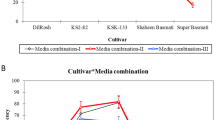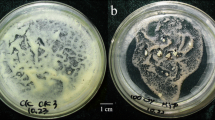Summary
Calli were initiated from seedling roots in rice (Oryza sativa L. var. Tadukan) and subcultured at 45-day intervals on MS medium supplemented with 2 mg/l 2,4-D. Sectors of callus which differentiated shoot meristems (green spots) under the same 2,4-D concentration were selected from the calli subcultured 90 days after initiation. The selection was continued for about 2 years. Responses to 2,4-D between original and selected lines differed considerably, although differentiation was not generally seen in rice callus in the presence of 2 mg/l 2,4-D. After 180 days, calli of the selected line differentiated into numerous shoot-bud primordia and grew out new callus tissues under 2 mg/l 2,4-D concentration; the frequency of the differentiation exceeded 90%. On the other hand, no calli of non-selected line differentiated into shootbuds under 2 mg/l 2,4-D, and the frequency of the shootbud was only about 50% under lower 2,4-D concentration (0.1 mg/l). The pattern and activity of peroxidase isozyme varied markedly between calli of the selected and non-selected lines. First, two strong peroxidase bands which show fast mobility and one intermediate peroxidase band with slow mobility were detected only in the calli of selected line. Secondly, changes in band pattern of proteins separated by SDS-PAGE were observed. In the calli of selected line, there was a loss of the polypeptide bands with molecular weight of 24 and 42 K in the selected calli, but they were clearly present in the unselected line. The appearance of new peroxidase isozyme bands and loss of polypeptide bands, change in response to auxin and increased ability for shoot bud differentiation are closely correlated to each other.
Similar content being viewed by others
References
Abe T, Futsuhara Y (1984) Varietal difference of plant regeneration from root callus tissues in rice. Jpn J Breed 34:147–155
Abe T, Futsuhara Y (1985) Efficient plant regeneration by somatic embryogenesis from root callus tissues of rice (Oryza sativa L.). J Plant Physiol 121:111–118
Ahloowalia BS (1982) Plant regeneration from callus culture in wheat. Crop Sci 22:405–410
Chaturvedi HC, Mitra GC (1975) A shift in morphogenetic pattern in Citrus callus tissue during prolonged culture. Ann Bot 39:683–687
Chu CC, Wang CC, Sun CS, Hsu C, Yin KC, Bi FY (1975) Establishment of an efficient medium for anther culture of rice through comparative experiments on the nitrogen sources. Sci Sin 16:659–688
Gengenbach BG, Green CE (1975) Selection of T-cytoplasm maize callus cultures resistant to Helminthosporium maydis race T pathotoxin. Crop Sci 15:645–649
Heyser JW, Dykes TA, DeMott KJ, Nabors MW (1983) High frequency long term regeneration of rice from callus culture. Plant Sci Lett 29:175–181
Inoue M, Maeda E (1980) Effect of auxin and cytokinins on the occurrence of green regions in rice callus cultures. Jpn J Crop Sci 49:167–174
Kevers C, Coumans M, DeGreef W, Jacobs M, Gaspar T (1981) Organogenesis in habituated sugarbeet callus: Auxin content and protectors, peroxidase pattern and inhibitors. Z Pflanzenphysiol 101:79–87
Laemmli UK (1970) Cleavage of structural proteins during the assembly of the head of bacteriophage T4. Nature 227:680–685
Larkin PJ, Scowcroft WR (1981) Somaclonal variation—a novel source of variation from cell culture for plant improvement. Theor Appl Genet 60:197–214
Murashige T, Skoog F (1962) A revised medium for rapid growth and bioassays with tobacco tissue culture. Physiol Plant 15:473–497
Oono K (1978) Test tube breeding of rice by tissue culture. Trop Agric Res Ser 11:109–123
Saka H, Maeda E (1974) Changes in some hydrolytic enzymes associated with the redifferentiation of shoots in rice callus tissues. Proc Crop Sci Soc Jpn 43:207–218
Sun Z, Zhao C, Zheng K, Oi X, Fu Y (1983) Somaclonal genetics of rice, Oryza sativa L. Theor Appl Genet 67:67–73
Swarnkar PL, Bohra SP, Chandra N (1986) Biochemical changes during growth and differentiation of the callus of Solanum surattense. J Plant Physiol 126:75–81
Thorpe TA, Gaspar T (1978) Changes in isoperoxidases during shoot formation in tobacco callus. In Vitro 14:522–526
Vasil V, Vasil IK (1981) Somatic embryogenesis and plant regeneration from tissue cultures of Pennisetum americanum and P. americanum x P. purpureum hybrid. Am J Bot 68:864–872
Wakasa K, Widholm JM (1987) A 5-methyltryptophan resistant rice mutant, MTRI, selected in tissue culture. Theor Appl Genet 74:49–54
Author information
Authors and Affiliations
Additional information
Communicated by G.S. Khush
Rights and permissions
About this article
Cite this article
Abe, T., Futsuhara, Y. Selection of higher regenerative callus and change in isozyme pattern in rice (Oryza sativa L.). Theoret. Appl. Genetics 78, 648–652 (1989). https://doi.org/10.1007/BF00262559
Received:
Accepted:
Issue Date:
DOI: https://doi.org/10.1007/BF00262559




